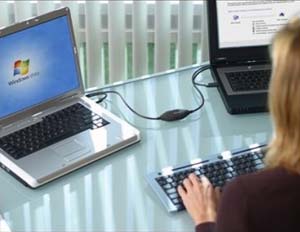The computer helper: Keeping Windows the way you like it
 Washington - As if keeping your Windows-based computer running wasn't hard enough, some users find that Windows has a way of changing all by itself. That can be unnerving, to say the least. What do you do, for example, if you find your taskbar suddenly getting smaller? Or how can you prevent others with whom you share your PC from changing your desktop? Read on for some answers.
Washington - As if keeping your Windows-based computer running wasn't hard enough, some users find that Windows has a way of changing all by itself. That can be unnerving, to say the least. What do you do, for example, if you find your taskbar suddenly getting smaller? Or how can you prevent others with whom you share your PC from changing your desktop? Read on for some answers.
Q: My Windows taskbar gets narrower every time I start my computer. Do I have a virus? I'm running Windows XP and one of the major antivirus programs.
A: No, you probably don't have a virus. But you probably do have your taskbar situated on the side of your monitor rather than the bottom, and you probably also have the Language Bar on the taskbar, which is activated by default.
For the benefit of others, here's what happens. You're using Windows XP with the taskbar to the side of the screen rather than the bottom. Each time you log off or restart the computer, upon logging on, you notice that the taskbar has become narrower. If you log off and on multiple times, the taskbar becomes very narrow - just the width of an icon.
This is a bug, and there's one way to solve it: remove the Language Bar from your taskbar. You'll need to visit the Control Panel to remove the Language Bar. Click Start, click Control Panel, and then double-click Regional and Language Options. On the Languages tab, under the "Text services and input languages" section, click the Details button. From the resulting Text Services and Input Languages dialog box, click the Language Bar button. The Language Bar Settings dialog box opens. Remove the check mark from the checkbox labeled "Show the Language bar on the desktop." Click OK, and the Language Bar should be gone from your taskbar.
To resize the taskbar to the width you prefer, right click an empty area of the taskbar, and make sure there is no check mark next to the Lock the Taskbar option on the pop-up menu. With the check mark removed, merely allow your mouse cursor to hover over the edge of the taskbar. The mouse cursor turns into a double-headed arrow, indicating that you can stretch the taskbar. With the double-headed arrow displayed, hold down your left mouse button and drag the taskbar to the width you desire. Release the mouse button, and then relock the taskbar.
Q: My wife and kids share my Windows computer, and frequently they'll change the layout of the taskbar and the Start menu, which annoys me. Is there some way that I can lock these parts of the screen so that they can't be changed?
A: Yes, you can use a little-known Windows utility that will allow you to put a virtual clamp on components of the desktop, making it impossible for others to alter the way you've set things up.
To do so, open the Run dialog box by holding down the Windows key and tapping the letter R. Type "gpedit. msc" into the Run dialog box, without the quotation marks, and press Enter. The Local Group Policy editor will open. This little application is divided into two panes.
In the left-hand pane, under the User Configuration section, expand the Administrative Templates tree. Then select the Start Menu and Taskbar folder. When you do, you'll see a list of options appear in the right-hand pane. Double-click the one labeled "Prevent changes to Taskbar and Start Menu Settings."
The resulting dialog box will have an option labeled "Enabled." Select that, and press OK. Doing so will prevent anyone else from changing your taskbar and Start menu. It will also prevent you from changing those elements, however, so be sure you have everything just the way you want it before enabling this. If you want to change things later, you'll have to retrace these steps and disable the setting before you'll be allowed to change the taskbar or Start menu.
Q: Every time I walk away from my computer for a few minutes, Windows locks my computer, and I have to enter the password to get back in. How can I fix this?
A: Most likely, it's the Windows screen saver that's locking your computer, requiring you to re-enter your password to log back on. The solution to this problem is twofold: set your screen saver to kick in less frequently, and, if desirable, stop the screen saver from requiring a password to re-enter your PC once the screen saver has kicked in. Right-click your Windows desktop. In Windows XP, select Properties, and then click the Screen Saver tab in the resulting dialog box. In Windows Vista, select Personalise, and then Screen Saver. There, you should uncheck the option to display the logon or Welcome screen when your display resumes, and you could also specify a longer period of time before the screen saver is initiated.
--- Have a computer question? Send it to the Computer Helper at jayd@csi.com. (dpa)